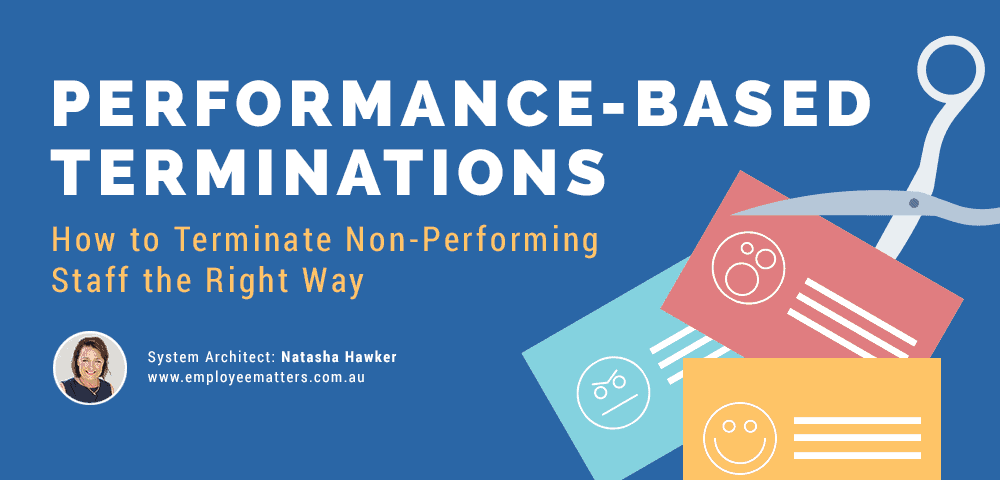
System Architect | Natasha Hawker: employeematters.com.au
Terminating an employee is never easy and a stressful situation, not only for the employee about to lose their job but for all parties involved, as it can also be a risky move for your business.
In fact, terminating an employee can affect the whole team, with pending work assignments and other staff who may start to question their own job security.
And because this process can be difficult, it’s also an emotionally charged one, making it easy to act counterproductively. Terminating someone the wrong way can lead to costly legal breaches, so doing it correctly is vital.
This 5-step system by Employee Relations expert Natasha Hawker, will guide you through conducting a performance-based employee termination process, the right way.
Types of non-performers
- Non-performance: the employee is not performing adequately in their role.
- Misconduct: the employee has an inappropriate attitude.
- Gross-misconduct: an employee verbally or physically insulted someone, or committed fraud.
The Employee Termination Process Based on Their Performance
Step 1: Have all the foundation steps in place.
- Review and complete the checklist.
- Have evidence – recorded calls, instructions that you had to repeat multiple times etc.
- State your expectations – tell them what you expect, what success looks like.
- Communicate with the employee that they are not performing and not meeting your expectations.
- Confirm the expected levels of performance. Ensure they are reasonable.
- Ask why performance is sub-par, find out if there’s a valid reason for it.
- Ask whether there are any extenuating circumstances for the performance.
- Arrange for additional training to adjust the performance.
- Legally you need to offer the employee a support person if going through any of the following conversations: redundancy conversation, restructure or performance management conversation, or misconduct conversation.
- If the individual is positive that they don’t want a support person, get them to sign a document that they’ve waived this right. If they are not prepared to sign that document, note that in your documents.
Step 2: Steps prior to a performance management meeting.
- Counselling sessions – suitable for minor issues.
- Employer to review the performance of the employee after the counselling session.
- A counselling session can occur a couple of times before moving to more formal warnings.
- Documentation is important – make a file note of the sessions that you’ve had.
- Warnings – no more than 3 strikes.
- It is recommended that all warnings, including verbal, to be documented.
- Prior to the final warning, and potential termination meeting, the employee must be in no doubt of the seriousness of the situation and that termination can be an outcome.
- Training – it is imperative that further training or support has been offered, including additional external training or mentor allocated.
- Instigate a without prejudice conversation – this is an alternative, off the record mutual separation discussion.
- In this case, you must get the employee to sign a date of release, that is sought by a lawyer.
Step 3: Script the performance management meeting.
- Plan the meeting. Script the conversation and practice it with someone else.
Step 4: Conduct a performance meeting.
- Ensure that you are prepared, that all paperwork has been completed as much as it can be prior to the meeting.
- Plan the meeting, have notes to guide you to be sure you cover everything.
- Suggestion: Ideally, have someone available to take notes.
- Book a quiet and private meeting space.
- Book the meeting with the individual stating it is to discuss their performance and they are welcome to bring a support person.
- Explain at the beginning the purpose of the meeting and the roles of the participants.
- Walk through each of the performance issues giving the employee a chance to respond. Where appropriate, provide evidence of the current performance level being achieved.
- Ask employee whether there’s anything that would assist them to improve their performance. Consider all requests, and then confirm what’s possible and what’s reasonable.
- Explain the required level of performance and the timeline to be reached.
- Summarise the outcomes of the meeting and next steps, and if the next meeting is termination as a potential outcome.
- After the meeting, the Minutes should be countersigned.
- If the employee is unwilling to do this, make a note of this fact.
Step 5: Deal with the emotional side.
- Be prepared and stay calm.
- Offer a short break.
- Always have tissues.
With this 5-step system to guide you through conducting performance-based terminations, you can have peace of mind that they will be performed the right way, without the worry of potential legal ramifications.
And because practice makes perfect, why not try using this system on a test case? Perhaps with a member of your HR team or a friend? That way, prior to any emotions potentially getting in the way, you’ve practiced and put the procedure in place.
Not sure where to start? Start here with this checklist from EmployeeMatters on ‘What do I do if an employee is not performing?’
Want to find out a little more? No problem! You can hear more from Natasha Hawker herself right here, in the video below.
System Architect – Natasha Hawker
Natasha Hawker is a business owner, who has been running Employee Matters with her husband and business partner Mark for the past five years, they have 9 employees. Employee Matters works with clients across Australia and has international clients from USA, UK and Asia. Employee Matters helps small to medium businesses hire better, manage better and if required, exit better.
She has worked in Employee Relations for over 23 years, working both nationally and internationally, including twelve years at Accenture, one of the top global management consulting firms. She is routinely featured in the SMH, Australian Financial Review and The Huffington Post and she is a regular writer for Flying Solo and Her Business. She has been nominated for the Telstra Businesswomen of the Year and Small Business of the Year and she has personally hired, managed and fired over 15, 000 employees.
She is also a professional speaker and author of ‘From Hire to Fire & Everything in Between’ which is available in all great bookstores, and also on Amazon.
But before life as an entrepreneur, Natasha had a successful corporate career and now she uses her corporate best practice knowledge and applies it in a way that makes commercial sense to small to midsize business. She is renowned for helping small business grow their businesses faster than ever before through their employees.













